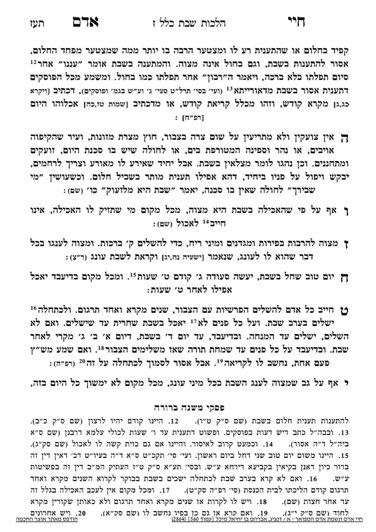The current series, which will cover seudos Shabbos and fasting on Shabbos, is available for sponsorship. Please contact Rabbi Reingold for more information.
We are continuing in siman 7, discussing the concept of reciting 100 brachos every day. We learned that during the week, it is usually not an issue, but Shabbos can be more challenging. One of the suggestions is eating extra food and making brachos on besamim in order to reach 100 brachos. We learned that generally, a person will be short 19 brachos, unless they recite birchas hamazon with a kos at all three meals, which would add six more brachos.
When the Chofetz Chaim makes his calculation, he assumes one will recite birchas hamazon on a kos, and writes that a person will find a way to work out the last 13.
If a person is not interested in eating various snacks, another option is to listen to the brachos of those receiving aliyos, and have in mind to be yotzei with them and respond Amen. the Pri Megadim concludes that even though for the purposes of shomeah k’oneh, a person is yotzei even if they do not recite amen (even though one is required to answer), over here, since the person is not actually chayav in the bracha (as only the oleh is chayav in the bracha), if a person wants the bracha to count for 100 brachos, they must respond amen.
On a regular Shabbos, there are 16 brachos on the laining (7 plus maftir, hence 8 x 2), 5 brachos on the haftorah, and 6 at mincha, for a total of 27 brachos.
When it comes to Yom Kippur, even with listening to the brachos of the laining, a person will still be three brachos short. Therefore, throughout the day, a person should be careful to make brachos on besamim in order to fulfill the takana of 100 brachos
In siman 8, the Chayei Adam discusses when the first day of Yom Tov falls out on Shabbos, which means the second day of Yom Tov will fall out on Motzei Shabbos. In order to have an appetite for the mitzvos of the second night of Yom Tov, the Chayei Adam writes that seudah shlishis should commence before the 10th hour begins, before three quarters of the day has passed. Nevertheless, if a person has not eaten before the beginning of the 10th hour, they should still eat seudah shlishis. When a person is unable to begin before the 10th hour, it is recommended to limit what one eats at seudah shlishis, in order to have a proper appetite for the mitzvos of Yom Tov.
Summary
- It is a mitzvah to increase snacks and delicacies on Shabbos, both for the oneg Shabbos and in order to reach 100 brachos.
- If a person does not want to eat additional foods, they can reach 100 brachos by having in mind to be yotzei and responding amen to the brachos of laining.
- If Motzei Shabbos is a Yom Tov, one should eat seudah shlishis before the 10th hour begins. If they are unable to eat before the 10th hour, they should still eat seudah shlishis, but should limit what they eat in order to maintain an appetite for the mitzvos of the night.



